(完整版)高中非谓语动词专题语法讲解
- 格式:ppt
- 大小:31.63 MB
- 文档页数:21
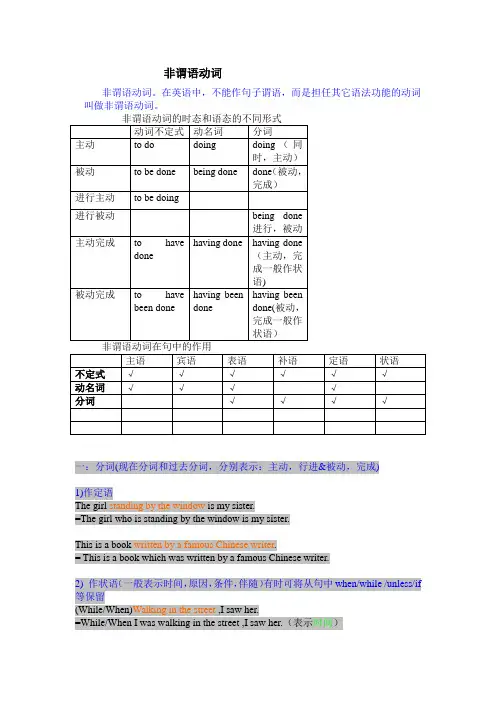
非谓语动词非谓语动词。
在英语中,不能作句子谓语,而是担任其它语法功能的动词叫做非谓语动词。
非谓语动词的时态和语态的不同形式动词不定式动名词分词主动to do doing doing(同时,主动)被动to be done being done done(被动,完成)进行主动to be doing进行被动being done进行,被动主动完成to havedone having done having done(主动,完成一般作状语)被动完成to havebeen done having beendonehaving beendone(被动,完成一般作状语)非谓语动词在句中的作用主语宾语表语补语定语状语不定式√√√√√√动名词√√√√分词√√√√一:分词(现在分词和过去分词,分别表示:主动,行进&被动,完成)1)作定语The girl standing by the window is my sister.=The girl who is standing by the window is my sister.This is a book written by a famous Chinese writer.= This is a book which was written by a famous Chinese writer.2) 作状语(一般表示时间,原因,条件,伴随)有时可将从句中when/while /unless/if 等保留(While/When)Walking in the street ,I saw her.=While/When I was walking in the street ,I saw her.(表示时间)Seen from the hill,our school looks more beautiful.=When our school is seen from the hill,it looks more beautiful.从小山上看,我们学校更美了。
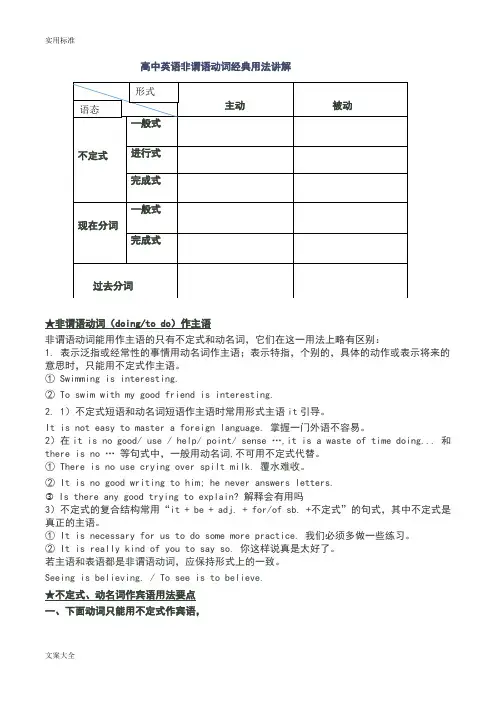
高中英语非谓语动词经典用法讲解★非谓语动词(doing/to do )作主语 非谓语动词能用作主语的只有不定式和动名词,它们在这一用法上略有区别: 1. 表示泛指或经常性的事情用动名词作主语;表示特指,个别的,具体的动作或表示将来的意思时,只能用不定式作主语。
① Swimming is interesting.② To swim with my good friend is interesting.2. 1)不定式短语和动名词短语作主语时常用形式主语it 引导。
It is not easy to master a foreign language. 掌握一门外语不容易。
2)在it is no good/ use / help/ point/ sense …,it is a waste of time doing... 和there is no … 等句式中,一般用动名词,不可用不定式代替。
① There is no use crying over spilt milk. 覆水难收。
② It is no good writing to him; he never answers letters.Is there any good trying to explain? 解释会有用吗3)不定式的复合结构常用“it + be + adj. + for/of sb. +不定式”的句式,其中不定式是真正的主语。
① It is necessary for us to do some more practice. 我们必须多做一些练习。
② It is really kind of you to say so. 你这样说真是太好了。
若主语和表语都是非谓语动词,应保持形式上的一致。
Seeing is believing. / To see is to believe.★不定式、动名词作宾语用法要点一、下面动词只能用不定式作宾语, 主动 被动 不定式 一般式 进行式 完成式现在分词 一般式 完成式 过去分词 语态 形式Decide / determine, learn, want, expect / hope / wish, refuse, manage, care, pretend, offer, promise, choose, plan, agree, ask / beg, help,afford, 例如:① She pretended not to see me when I passed by.② We agreed to meet here but so far she hasn’t turned up yet.二、下列动词只能用动名词作宾语,请牢记下列小诗:consider / suggest / advise, look forward to, excuse, pardon, admit, delay/ put off, fancy, avoid, miss, keep / keep on, practise, deny, finish, enjoy / appreciate, can’t help, mind, allow / permit, escape, imagine, forbid, risk此外be used to, look forward to, lead to, devote to, stick to, object to, get down to, pay attention to, can’t stand (无法忍受), give up, feel like, insist on, put off, thank you for, apologize for, be busy (in), have difficulty / trouble (in), have a good / wonderful /hard time /difficulty (in)等动词词组也要用动名词作宾语。

高中英语:非谓语动词考点全总结!含义+用法+例题讲解,三合一教会你!非谓语动词的含义非谓语动词首先是一种动词形式,其次是这种动词形式不能做谓语,综合这两点,我们将其叫做非谓语动词。
非谓语动词的形式非谓语动词包含四种形式,即不定式、动名词、现在分词和过去分词。
其中,每种形式按照发生时间和主被动又包括不同的子形式。
具体如下:1. 不定式①基本形式:to do(表示主动,并且一般表示将来)②被动式:to be done(表示被动,并且一般表示将来)③进行式:to be doing (表示主动和进行)④完成时:to have done(表示主动和完成)⑤完成被动式:to have been done(表示被动和完成)⑥完成进行式:to have been doing (表示主动和完成进行)The teacher told us to do morning exercises. 老师让我们做早操。
The car to be bought is for his sister.要买的这辆车是给他的姐姐的。
She pretended to be reading when the teacher came into the classroom.老师进来时,她假装正在读书。
The thief is said to have escaped.据说小偷已经逃跑了。
The thief is said to have been arrested.据说小偷已经被抓住了。
She is said to have been working in the factory over the last 20 years.据说在过去的20年里,她一直在这家工厂工作。
2. 动名词①基本形式:doing (表示主动)②被动式:being done(表示被动)③完成式:having done(表示主动和完成)④完成被动式:having been done(表示被动和完成)Travelling in space by ordinary people will be common in the future.在未来,普通人在太空旅行将会是普遍的事情。
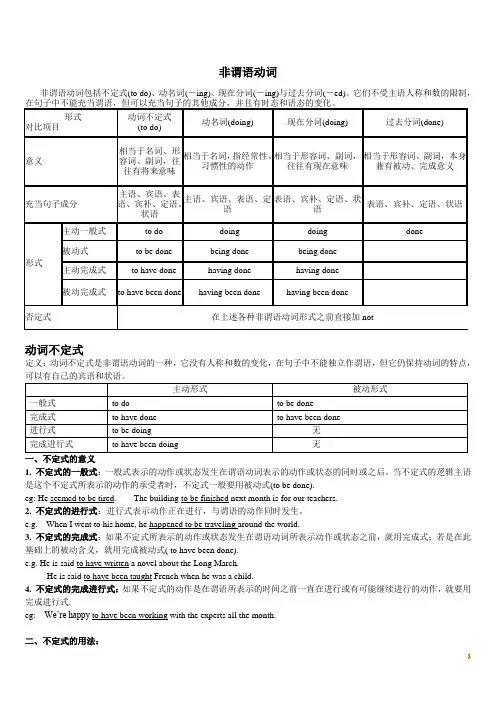
非谓语动词非谓语动词包括不定式(to do)、动名词(-ing)、现在分词(-ing)与过去分词(-ed)。
它们不受主语人称和数的限制,动词不定式定义:动词不定式是非谓语动词的一种,它没有人称和数的变化,在句子中不能独立作谓语,但它仍保持动词的特点,一、不定式的意义1. 不定式的一般式:一般式表示的动作或状态发生在谓语动词表示的动作或状态的同时或之后。
当不定式的逻辑主语是这个不定式所表示的动作的承受者时,不定式一般要用被动式(to be done).eg: He seemed to be tired. The building to be finished next month is for our teachers.2. 不定式的进行式:进行式表示动作正在进行,与谓语的动作同时发生。
e.g. When I went to his home, he happened to be traveling around the world.3. 不定式的完成式:如果不定式所表示的动作或状态发生在谓语动词所表示动作或状态之前,就用完成式;若是在此基础上的被动含义,就用完成被动式( to have been done).e.g. He is said to have written a novel about the Long March.He is said to have been taught French when he was a child.4. 不定式的完成进行式:如果不定式的动作是在谓语所表示的时间之前一直在进行或有可能继续进行的动作,就要用完成进行式.eg: We’re happy to have been working with the experts all the month.二、不定式的用法:1. 不定式做主语:不定式做主语一般表示具体的某次动作。
而动名词doing 表示习惯的,经常的动作。
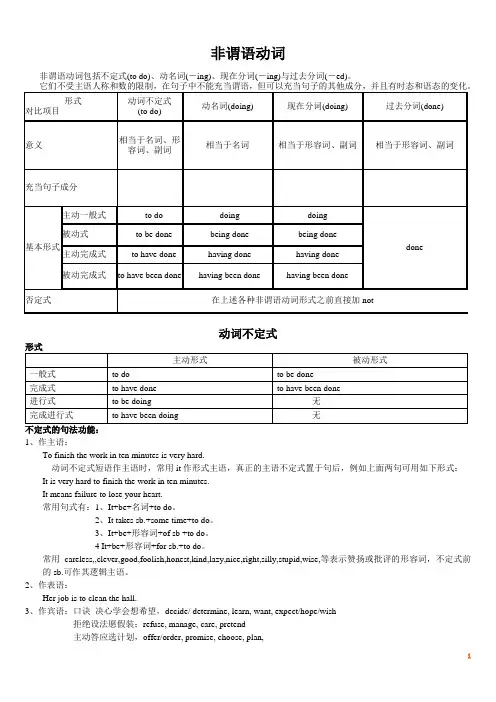
非谓语动词非谓语动词包括不定式(to do)、动名词(-ing)、现在分词(-ing)与过去分词(-ed)。
动词不定式不定式的句法功能:1、作主语:To finish the work in ten minutes is very hard.动词不定式短语作主语时,常用it作形式主语,真正的主语不定式置于句后,例如上面两句可用如下形式:It is very hard to finish the work in ten minutes.It means failure to lose your heart.常用句式有:1、It+be+名词+to do。
2、It takes sb.+some time+to do。
3、It+be+形容词+of sb +to do。
4 It+be+形容词+for sb.+to do。
常用careless,,clever,good,foolish,honest,kind,lazy,nice,right,silly,stupid,wise,等表示赞扬或批评的形容词,不定式前的sb.可作其逻辑主语。
2、作表语:Her job is to clean the hall.3、作宾语:口诀决心学会想希望,decide/ determine, learn, want, expect/hope/wish拒绝设法愿假装;refuse, manage, care, pretend主动答应选计划,offer/order, promise, choose, plan,同意请求帮一帮。
agree, ask/beg, help如果不定式(宾语)后面有宾语补足语,则用it作形式宾语,真正的宾语(不定式)后置,放在宾语补足语后面,例如:Marx found it important to study the situation in Russia.动词不定式也可充当介词宾语,如:I have no choice but to stay here.He did nothing last Sunday but repair his bike.动词不定式前有时可与疑问词连用,如:He gave us some advice on how to learn English.4、作宾语补足语:在复合宾语中,动词不定式可充当宾语补足语,如下动词常跟这种复合宾语:want, wish, ask, tell, order, beg, permit, help, advise, persuade, allow, prepare, cause, force, call on, wait for, invite.此外,介词有时也与这种复合宾语连用,如:With a lot of work to do, he didn't go to the cinema.有些动词如在使役动词make, have, let和感官动词see, watch, notice, observe, feel, hear, listen to, look at等词后接不定式作宾补,不定式不带to,表示做某事的全过程。
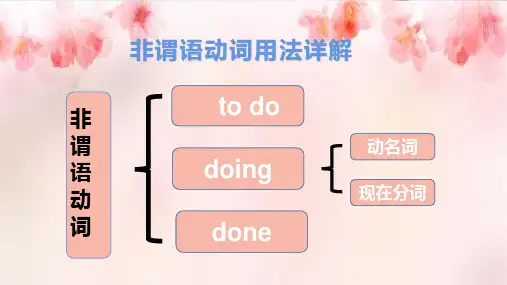

⾼中英语语法⾮谓语动词讲解⾮谓语动词●概述⾮谓语动词,主要指在主句中表⽰⼀个动作但不能充当谓语,⽽是充当其他语法功能的词。
⾮谓语动词没有⼈称和数的变化,但是有语态和时态的变化。
●⾮谓语动词的三种形式⾮谓语动词有三种:动词不定式、动名词和分词。
这三个基本形式的基础上会有⼀些变化:1.动词不定式2.动名词3.分词●动词不定式的⽤法1.动词不定式的否定式not toShe decided not to be late again.2.动词不定式的完成式完成式表⽰的动作或状态发⽣在位于动词表⽰的动作或状态之前。
I am sorry to have kept you waiting.注意若谓语为表⽰“愿望、打算、意图”的动词时,如hope, think, want, plan, expect, mean, intend等,其后可以跟不定式的完成式表⽰“本来想要或打算做某事,⽽实际上未能实现”。
如:We meant to have stopped him from doing such a thing.征,则构成不定式符合结构的介词应为of前⾯常⽤的形容词有:kind, nice, foolish, silly, stupid, rude, cruel, wise, clever, brace, selfish, crazy, good, careful, careless, impolite, right, wrong等。
It is very kind of you to help me.区别It is important for us to learn English well.4.在某些动词后,可⽤it做形式宾语,然后加宾语补⾜语,最后加不定式作真正的并于。
常见的动词有find, think consider, feel, make等。
They find it difficult to repay the money.5.动词+不定式作宾补ask, want, invite, get, force, expect, allow, persuade, order, warn, remind order, cause, permit, forbid, advise, teach等。
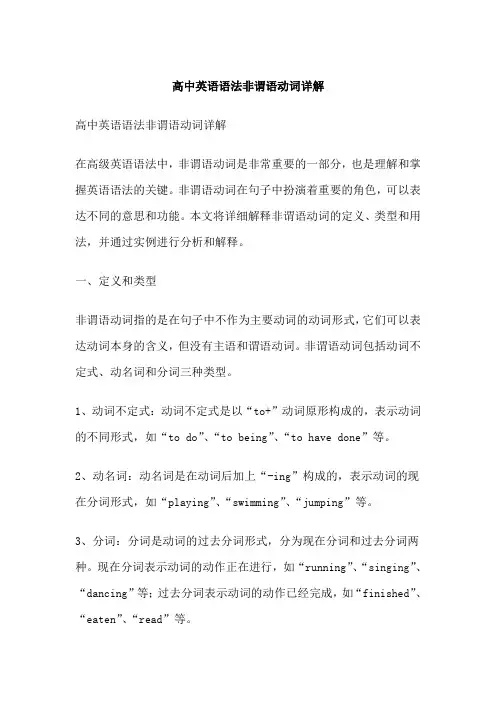
高中英语语法非谓语动词详解高中英语语法非谓语动词详解在高级英语语法中,非谓语动词是非常重要的一部分,也是理解和掌握英语语法的关键。
非谓语动词在句子中扮演着重要的角色,可以表达不同的意思和功能。
本文将详细解释非谓语动词的定义、类型和用法,并通过实例进行分析和解释。
一、定义和类型非谓语动词指的是在句子中不作为主要动词的动词形式,它们可以表达动词本身的含义,但没有主语和谓语动词。
非谓语动词包括动词不定式、动名词和分词三种类型。
1、动词不定式:动词不定式是以“to+”动词原形构成的,表示动词的不同形式,如“to do”、“to being”、“to have done”等。
2、动名词:动名词是在动词后加上“-ing”构成的,表示动词的现在分词形式,如“playing”、“swimming”、“jumping”等。
3、分词:分词是动词的过去分词形式,分为现在分词和过去分词两种。
现在分词表示动词的动作正在进行,如“running”、“singing”、“dancing”等;过去分词表示动词的动作已经完成,如“finished”、“eaten”、“read”等。
二、非谓语动词的用法非谓语动词在句子中可以扮演不同的成分,如主语、宾语、状语等。
下面我们通过具体的例子来分析非谓语动词的用法:1、动词不定式:在句子中,动词不定式可以作为主语、宾语和状语等。
例如,“To learn English is important”(学习英语很重要)中,动词不定式“to learn English”作为主语;或者在“I want to go home”(我想回家)中,动词不定式“to go home”作为宾语。
2、动名词:在句子中,动名词可以作为主语、宾语和状语等。
例如,“Playing sports is fun”(做运动很有趣)中,动名词“Playing sports”作为主语;或者在“I enjoy listening to music”(我喜欢听音乐)中,动名词“listening to music”作为宾语。

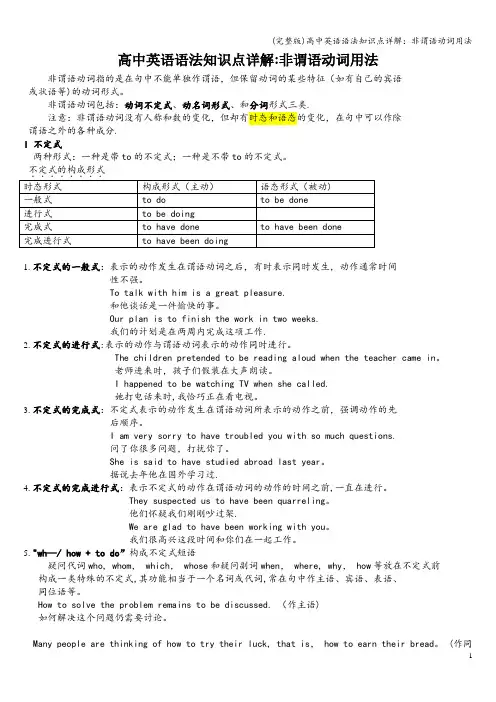
高中英语语法知识点详解:非谓语动词用法非谓语动词指的是在句中不能单独作谓语,但保留动词的某些特征(如有自己的宾语或状语等)的动词形式。
非谓语动词包括:动词不定式、动名词形式、和分词形式三类.注意:非谓语动词没有人称和数的变化,但却有时态和语态的变化,在句中可以作除谓语之外的各种成分.I 不定式两种形式:一种是带to的不定式;一种是不带to的不定式。
不定式的构成形式1.不定式的一般式:表示的动作发生在谓语动词之后,有时表示同时发生,动作通常时间性不强。
To talk with him is a great pleasure.和他谈话是一件愉快的事。
Our plan is to finish the work in two weeks.我们的计划是在两周内完成这项工作.2.不定式的进行式:表示的动作与谓语动词表示的动作同时进行。
The children pretended to be reading aloud when the teacher came in。
老师进来时,孩子们假装在大声朗读。
I happened to be watching TV when she called.她打电话来时,我恰巧正在看电视。
3.不定式的完成式:不定式表示的动作发生在谓语动词所表示的动作之前,强调动作的先后顺序。
I am very sorry to have troubled you with so much questions.问了你很多问题,打扰你了。
She is said to have studied abroad last year。
据说去年他在国外学习过.4.不定式的完成进行式:表示不定式的动作在谓语动词的动作的时间之前,一直在进行。
They suspected us to have been quarreling。
他们怀疑我们刚刚吵过架.We are glad to have been working with you。
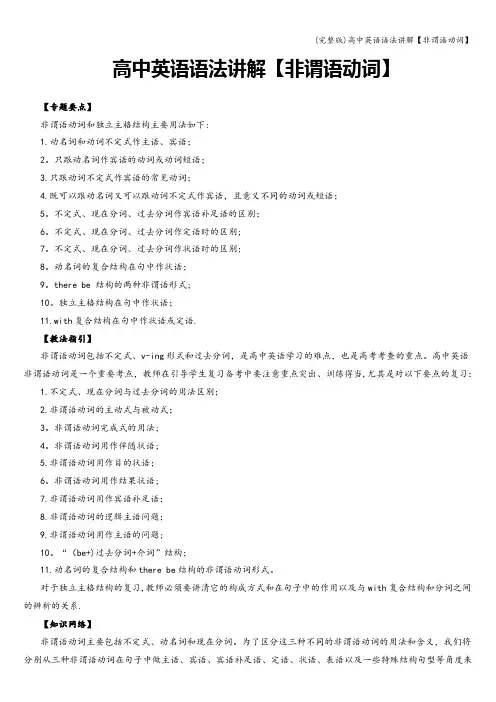
高中英语语法讲解【非谓语动词】【专题要点】非谓语动词和独立主格结构主要用法如下:1.动名词和动词不定式作主语、宾语;2。
只跟动名词作宾语的动词或动词短语;3.只跟动词不定式作宾语的常见动词;4.既可以跟动名词又可以跟动词不定式作宾语,且意义不同的动词或短语;5。
不定式、现在分词、过去分词作宾语补足语的区别;6。
不定式、现在分词、过去分词作定语时的区别;7。
不定式、现在分词、过去分词作状语时的区别;8。
动名词的复合结构在句中作状语;9。
there be 结构的两种非谓语形式;10。
独立主格结构在句中作状语;11.with复合结构在句中作状语或定语.【教法指引】非谓语动词包括不定式、v-ing形式和过去分词,是高中英语学习的难点,也是高考考查的重点。
高中英语非谓语动词是一个重要考点,教师在引导学生复习备考中要注意重点突出、训练得当,尤其是对以下要点的复习:1.不定式、现在分词与过去分词的用法区别;2.非谓语动词的主动式与被动式;3。
非谓语动词完成式的用法;4。
非谓语动词用作伴随状语;5.非谓语动词用作目的状语;6。
非谓语动词用作结果状语;7.非谓语动词用作宾语补足语;8.非谓语动词的逻辑主语问题;9.非谓语动词用作主语的问题;10。
“(be+)过去分词+介词”结构;11.动名词的复合结构和there be结构的非谓语动词形式。
对于独立主格结构的复习,教师必须要讲清它的构成方式和在句子中的作用以及与with复合结构和分词之间的辨析的关系.【知识网络】非谓语动词主要包括不定式、动名词和现在分词。
为了区分这三种不同的非谓语动词的用法和含义,我们将分别从三种非谓语动词在句子中做主语、宾语、宾语补足语、定语、状语、表语以及一些特殊结构句型等角度来区分其用法和细微含义。
1.不定式和动名词作主语的区别(1)动名词作主语通常表示抽象动作;而不定式作主语表示具体动作.Smoking is prohibited(禁止)here.这里禁止抽烟。
高中英语非谓语动词讲解非谓语动词包括不定式(to do)、动名词(-ing)、现在分词(-ing)和过去分词(-ed)。
它们不受主语人称和数的限制,不能充当谓语,但可以充当句子的其他成分,并且有时态和语态的变化。
动词不定式没有人称和数的变化,不能独立作谓语,但可以有自己的宾语和状语。
一般式表示的动作或状态发生在谓语动词表示的动作或状态的同时或之后,而进行式表示动作正在进行,与谓语的动作同时发生。
动名词相当于名词,可以作主语、宾语、表语、宾补、定语和状语。
它往往有将来意味,指经常性、惯性的动作或有现在意味。
现在分词和过去分词分别相当于形容词和副词,可以作定语和状语。
现在分词往往有进行意味,而过去分词则表示被动或完成的意义。
在上述各种非谓语动词形式之前直接加not可以构成否定式。
此外,动词不定式还有完成式、进行式和完成进行式,分别表示完成、正在进行和完成正在进行的动作或状态。
被动形式则表示该动作或状态的承受者。
需要注意的是,当不定式的逻辑主语是这个不定式所表示的动作的承受者时,不定式一般要用被动式(to be done)。
例如,The building to be finished next month is for our ___.3.关于不定式的完成式:当不定式所表示的动作或状态发生在谓语动词所表示的动作或状态之前时,使用完成式。
如果带有被动含义,则使用完成被动式(to have been done)。
例如:据说他写了一本关于长征的小说。
他据说在儿时学过法语。
4.关于不定式的完成进行式:如果不定式的动作在谓语所表示的时间之前一直在进行或可能继续进行,则使用完成进行式。
例如:我们很高兴一整个月都在和专家们一起工作。
二、不定式的用法:1.不定式做主语:不定式作主语一般表示具体的某次动作,而动名词doing则表示惯性的、经常性的动作。
具体表现为:1)不定式作主语时,谓语使用单数形式,例如:做这样的事情是愚蠢的。
非谓语动词语法详解.一.主语.1. 动名词和不定式作主语时,都可以用it 作形式主语,构成句型:it +be +表语+to do /doing sth. 当用作表语的是important , essential, necessary , unnecessary, possible, impossible, easy , difficult 等表示客观情况的形容词时,常用不定式作主语;当用作表语的是no use, no good, useful, useless, worth, worth while, a waste of time 等表主观短语时,常用动名词作主语。
Eg: it is important for us students to learn english well.It is impossible for them to finish the work within two hours.It is no use arguing with him about the matter.I don’t think it’s much good writing to him.It’s a waste of time trying to persuade her to agree.2.动名词短语作主语时表示抽象动作,通常不与特定的动作执行者联系在一起;不定式作主语表示具体动作,往往与特定的动作执行者联系在一起。
Eg: lying is wrong. (泛指)To lies is wrong. (特指)It’s no use crying over split milk.He realized that it was no use to go on like this.二.. 非谓语作宾语1.1)Would you mind lending me your English dictionary for a while?2) She can’t help crying after she listened to the sad story .3) I suggested trying it in a different way .4) I ‘ve been looking forward to hearing from you for a long time.5) He insisted on finishing the work before going home.6) Upon returning from Beijing, he went to visit his friends.7) He took a great delight in helping others.8) he didn’t metion having met me .9) I still remember having ever worked with him .10) I enjoyed watching TV program in the evening.11) the car needs reparing .12) the problem deserves explaining .13) This phonomenon requires studying carefully.14) The book is worth reading We don’t allow smoking in the classroom.He dislikes seeing her again.Mary is considering going abroad.Have you finished checking these machines?Working conditions keep improving, and production keeps going up , as well. He really appreciates having time to relax.He is fond of learning English.She left without telling me.1) I need to fetch a tape from a friend2) do you want me to find one stamp for you ?3) I have arranged to meet here at 10:00.I’d prefer to walk there this morning.I’d hate to leave you like that .She’d like to chat with university students.扩:1) agree , afford , aim , apply , arrange, ask , choose, claim, decide, demand, determine, fail , hope , learn , offer, plan , pretend, promise, refuse, want 等后只用to do .2)admit , allow , appreciate , avoid , consider, deny , dislike, encourage,enjoy, escape , excuse, finish , forbid , imagine, keep , mind , permit , practice 等词后只用doing3)stop doing sth / to do sth 停止做某事/停下来去做某事remember doing sth/ to do sth. 记得做过某事/记住要去做某事forget doing sth/ to do sth 记了做过某事/ 忘了做某事regret doing sth / to do sth 后悔做过某事/ 遗憾地。
非谓语动词在句中充当除谓语以外的句子成分的动词形式叫做非谓语动词。
非谓语动词分为三种形式:不定式、动名词和分词(分词包括现在分词和过去分词)不定式、动名词和现在分词都有时态和语态的变化.不定式主动语态被动语态与谓语动词的关系一般式To do To be done 动作发生在谓语动作之后进行式To be doing 与谓语动作同时发生完成式To have done To have been done 动作发生在谓语动作之前动名词主动语态被动语态与谓语动词的关系一般式Doing Being done 与谓语动作同时发生完成式Having doing Having been done 动作发生在谓语动作之前现在分词主动语态被动语态与谓语动词的关系一般式Doing Being done 与谓语动作同时发生完成式Having done Having been done 动作发生在谓语动作之前不定式一、不定式的作用1、作主语不定式作主语时,谓语用单数。
往往用it 作形式主语,把不定式放在谓语后面。
如:It took us two hours to finish the job.It is impossible for us to get there on time.It is very kind of you to help us.注意:(1)其他系动词如look, appear等也可用于此句型。
(2)当不定式作主语的句子中又有一个不定式作表语时,不能用It is …to…的句型。
试比较:It is to negate my own idea to believe him.(错)To believe him is to negate my own idea .(对)(3)It is+ adj. of / for sb. to do sth. 结构中,当不定式的逻辑主语和前面的形容词可以构成系表结构时,用of, 否则用for.2、作宾语(1)动词+不定式。